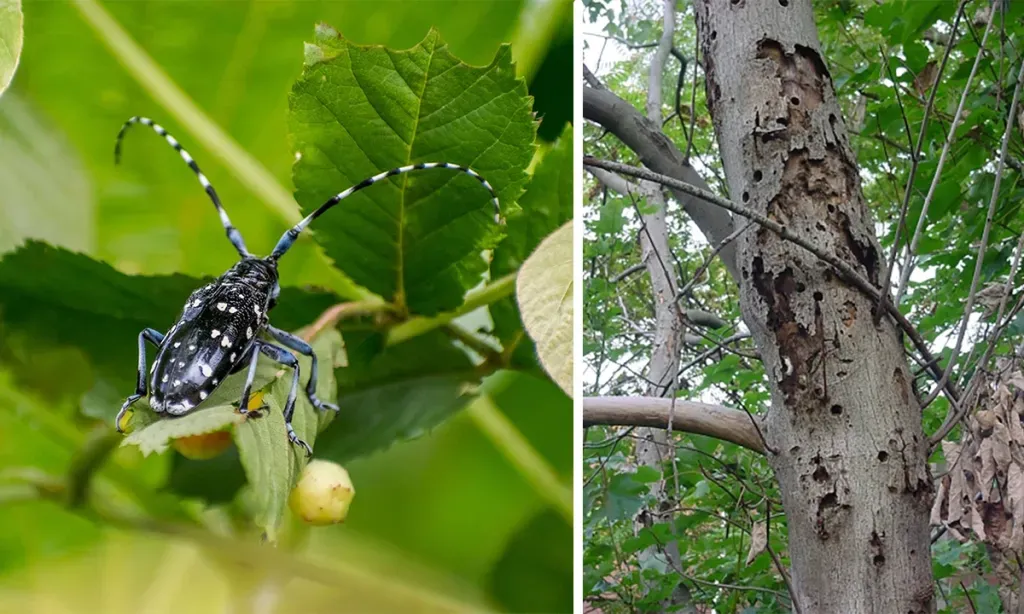APHIS Declares August is “Tree Check Month,” Asks Public to Check Trees for Signs of Asian Longhorned Beetle

Press Release
Contact: aphispress@usda.gov
APHIS Declares August is “Tree Check Month,” Asks Public to Check Trees for Signs of Asian Longhorned Beetle
WASHINGTON, D.C., July 28, 2025—The U.S. Department of Agriculture’s Animal and Plant Health Inspection Service (APHIS) is asking the public to look for and report signs of the Asian longhorned beetle (ALB). APHIS declares August is “Tree Check Month” and asks everyone to look for signs of this destructive, invasive beetle by checking trees on your property and in your community for damage. Left unchecked, ALB can cause infested trees to die.
“August is an ideal time of year to look for the beetle and the damage it causes,” said Josie Ryan, APHIS’ National Operations Manager for the ALB Eradication Program. “Adult beetles are emerging now. You can see them on trees and other nearby items. Finding and reporting infested trees early means we can save more trees.”
The ALB is a wood-boring beetle that attacks 12 types of hardwood trees. The insect prefers maple trees, but it also likes to attack birches, buckeyes, elms, and willows. Sometimes it attacks ash, golden rain tree, katsura, London plane tree, mimosa, mountain ash, and poplar. Infested trees become safety hazards. Branches can drop and trees can fall over, especially during storms.
In its larval stage, the insect feeds deep inside tree trunks and branches. It creates tunnels as it feeds. Then as an adult, the beetle chews its way out, creating 3/4-inch round exit holes. Once the beetles exit a tree, they feed on its leaves and bark before mating, laying eggs, and starting another generation of tree-killing beetles.
The adult beetle has markings that are easy to recognize:
- A shiny, black body with white spots. Its body is about 1” to 1-1/2” long.
- Black and white antennae that are longer than its body.
- Six legs and feet that can appear bluish.
Signs that a tree might be infested include:
- Round exit holes in tree trunks and branches about the size of a dime or smaller.
- Egg sites, or chewed spots, on the bark about the size of a quarter. Sap may weep out from these.
- Sawdust-like material called frass found on the tree, ground, or tree branches.
- Branches or limbs dying or falling from an otherwise healthy-looking tree.
How You Can Help
Check your trees for this pest: Look for and report any sightings of the beetle or the tree damage it causes. And don’t move materials that the beetle may be in, such as firewood. Doing this can keep infestations from spreading to new locations.
Report signs of ALB: If you think you found a beetle or tree damage, report it by calling the ALB hotline at 1-866-702-9938. Or submit an online report through the ALB web page. Try to photograph the beetle or tree damage. If you can, capture the beetle in a durable container and freeze it. This helps preserve the insect for identification.
Reduce spread: If you live in an ALB quarantine area, please keep ALB from spreading by following state and federal laws. These laws restrict the movement of woody material and untreated firewood, as they could contain ALB.
For more information about ALB and program activities, call 1-866-702-9938 or visit www.aphis.usda.gov/plant-pests-diseases/alb.
A Real Threat, A Real Response
ALB arrived in the United States in the 1990s in untreated wood shipping crates. Despite eliminating this pest from Illinois and New Jersey, the 30+ year battle continues in Massachusetts, New York, Ohio, and South Carolina. ALB is just one example of the costly and destructive biological threats our country faces.
In July, Secretary Rollins announced USDA’s National Farm Security Action Plan, which elevates agriculture as a key element of our nation’s national security and calls for aggressive action to safeguard plant and animal health. This includes protecting our country’s vast and pristine forests from unintentional and deliberate foreign biological threats.
#
USDA is an equal opportunity provider, employer, and lender.

